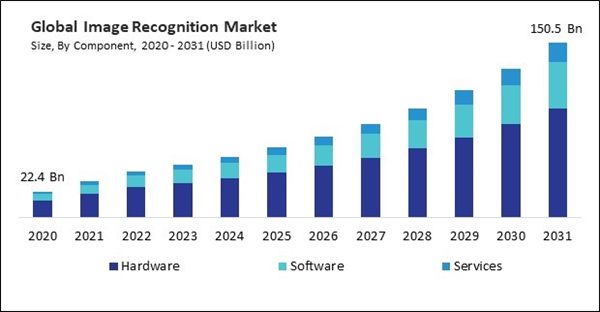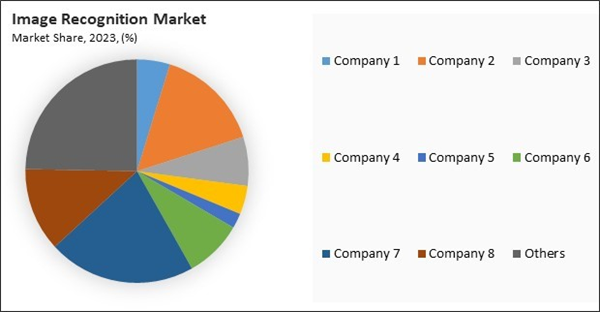The Global Image Recognition Market size is expected to reach $150.5 billion by 2031, rising at a market growth of 16.3% CAGR during the forecast period.
Facial recognition technology is increasingly adopted for security and surveillance, consumer electronics, and personal identification. This technology's use in smartphones, at airports for security checks, and by law enforcement agencies to identify individuals illustrates its wide-ranging applications. Consequently, the Facial Recognition segment would acquire nearly 16.8% market share by 2031. The increasing concern for security and personal verification solutions, along with advancements in AI, have driven the adoption and market growth of facial recognition technology.
This recognition is among the numerous technological domains that have been transformed by advancements in artificial intelligence (AI) and machine learning. In security, deep learning has greatly benefited facial recognition technologies. Systems can now identify individuals with greater precision in various lighting conditions and angles, enhancing security measures in public spaces and airports. Hence, these advancements will aid in the growth of the market. Additionally, The generation and utilization of digital imagery have been significantly influenced by the proliferation of digital devices, including tablets, smartphones, and other devices that are equipped with high-resolution cameras. Moreover, the demand for advanced image processing solutions is driven by the need to manage and make sense of this vast data. Thus, the proliferation of digital devices with advanced imaging capabilities is aiding in the development of the market.
However, Implementing advanced recognition systems involves considerable costs that can be daunting, especially for smaller businesses or startups. Maintenance and ongoing development further add to the costs. These recognition technologies are not static; they require continuous updates and improvements to stay effective. Hence, the substantial cost of this recognition may impede their adoption.
The leading players in the market are competing with diverse innovative offerings to remain competitive in the market. The above illustration shows the percentage of revenue shared by some of the leading companies in the market. The leading players of the market are adopting various strategies in order to cater demand coming from the different industries. The key developmental strategies in the market are Acquisitions, and Partnerships & Collaborations.
Facial recognition technology is increasingly adopted for security and surveillance, consumer electronics, and personal identification. This technology's use in smartphones, at airports for security checks, and by law enforcement agencies to identify individuals illustrates its wide-ranging applications. Consequently, the Facial Recognition segment would acquire nearly 16.8% market share by 2031. The increasing concern for security and personal verification solutions, along with advancements in AI, have driven the adoption and market growth of facial recognition technology.
This recognition is among the numerous technological domains that have been transformed by advancements in artificial intelligence (AI) and machine learning. In security, deep learning has greatly benefited facial recognition technologies. Systems can now identify individuals with greater precision in various lighting conditions and angles, enhancing security measures in public spaces and airports. Hence, these advancements will aid in the growth of the market. Additionally, The generation and utilization of digital imagery have been significantly influenced by the proliferation of digital devices, including tablets, smartphones, and other devices that are equipped with high-resolution cameras. Moreover, the demand for advanced image processing solutions is driven by the need to manage and make sense of this vast data. Thus, the proliferation of digital devices with advanced imaging capabilities is aiding in the development of the market.
However, Implementing advanced recognition systems involves considerable costs that can be daunting, especially for smaller businesses or startups. Maintenance and ongoing development further add to the costs. These recognition technologies are not static; they require continuous updates and improvements to stay effective. Hence, the substantial cost of this recognition may impede their adoption.
The leading players in the market are competing with diverse innovative offerings to remain competitive in the market. The above illustration shows the percentage of revenue shared by some of the leading companies in the market. The leading players of the market are adopting various strategies in order to cater demand coming from the different industries. The key developmental strategies in the market are Acquisitions, and Partnerships & Collaborations.
Driving and Restraining Factors
Drivers- Advancements in AI and machine learning
- Proliferation of digital devices
- Growth of e-commerce and online platforms
- High Costs of Implementation
- Substantial privacy concerns associated with image recognition
- Investments in research and development
- Increased focus on security and surveillance
- Substantial accuracy and reliability issues
- Competition from alternative technologies
Deployment Mode Outlook
Based on deployment mode, the market is segmented into cloud and on-premise. The on-premise segment recorded 34% revenue share in the market in 2023. Sectors like government, healthcare, and banking might prefer on-premise solutions to adhere to stringent data protection regulations, ensuring that sensitive information does not leave the physical premises. On-premise solutions also offer better customization to specific requirements, which is critical in settings where very specialized recognition functions are needed.Vertical Outlook
By vertical, the market is divided into BFSI, media & entertainment, retail & consumer goods, telecom & IT, government, healthcare, transportation & logistics, and others. The telecom & IT segment witnessed 20% revenue share in the market in 2023. Telecom companies increasingly use this recognition technologies to monitor and maintain infrastructure. For example, this recognition can help identify and diagnose issues in vast networks of cables, towers, and other equipment, reducing downtime and optimizing service delivery.Component Outlook
Based on component, the market is characterized into hardware, software, and services. The software segment procured 25.2% revenue share in the market in 2023. This segment covers the algorithms and computational models that process and analyze images. Given the increasing sophistication of machine learning and AI technologies, software is pivotal in expanding the capabilities of these recognition systems.Application Outlook
On the basis of application, the market is classified into scanning & imaging, security & surveillance, image search, marketing & advertising, and others. The security & surveillance segment acquired 25% revenue share in the market in 2023. This recognition technologies are integral in enhancing security measures, with applications ranging from monitoring public spaces and managing crowd control to sophisticated systems for detecting unauthorized access or identifying criminal activities.Technology Outlook
On the basis of technology, the market is divided into code recognition, digital image processing, facial recognition, object recognition, pattern recognition, and others. The digital image processing segment garnered 21% revenue share in the market in 2023. This segment involves techniques to enhance image quality and extract useful information from digital images using various algorithms and systems. Its applications span sectors such as healthcare, medical imaging analysis, automotive, enhancing and processing images from vehicle cameras, and surveillance, where image quality and clarity are crucial.Regional Outlook
Region-wise, the market is analyzed across North America, Europe, Asia Pacific, and LAMEA. The North American segment acquired 41% revenue share in the market in 2023. North America, particularly the United States and Canada, has a robust technological infrastructure and hosts many leading technology companies that are pioneers in AI and these recognition technologies, such as Google, Microsoft, and IBM.List of Key Companies Profiled
- Hitachi, Ltd.
- Microsoft Corporation
- NEC Corporation
- Thales Group S.A.
- 3M Company
- Cognitec Systems GmbH (Salto Systems, S.L.)
- IBM Corporation
- Onfido Limited (Entrust Corporation)
- Qualcomm Incorporated (Qualcomm Technologies, Inc.)
- Google LLC (Alphabet Inc.)
Market Report Segmentation
By Deployment Mode- Cloud
- On-Premise
- BFSI
- Media & Entertainment
- Retail & Consumer Goods
- Telecom & IT
- Government
- Healthcare
- Transportation & Logistics
- Others
- Hardware
- Software
- Services
- Professional Services
- Implementation
- Consulting & Training
- Support & Maintenance
- Managed Services
- Scanning & Imaging
- Security & Surveillance
- Image Search
- Marketing & Advertising
- Others
- Code Recognition
- Digital Image Processing
- Facial Recognition
- Object Recognition
- Pattern Recognition
- Others
- North America
- US
- Canada
- Mexico
- Rest of North America
- Europe
- Germany
- UK
- France
- Russia
- Spain
- Italy
- Rest of Europe
- Asia Pacific
- China
- Japan
- India
- South Korea
- Singapore
- Malaysia
- Rest of Asia Pacific
- LAMEA
- Brazil
- Argentina
- UAE
- Saudi Arabia
- South Africa
- Nigeria
- Rest of LAMEA
Table of Contents
Chapter 1. Market Scope & Methodology
Chapter 2. Market at a Glance
Chapter 3. Market Overview
Chapter 4. Competition Analysis - Global
Chapter 5. Global Image Recognition Market by Deployment Mode
Chapter 6. Global Image Recognition Market by Vertical
Chapter 7. Global Image Recognition Market by Component
Chapter 8. Global Image Recognition Market by Application
Chapter 9. Global Image Recognition Market by Technology
Chapter 10. Global Image Recognition Market by Region
Chapter 11. Company Profiles
Companies Mentioned
- Hitachi, Ltd.
- Microsoft Corporation
- NEC Corporation
- Thales Group S.A.
- 3M Company
- Cognitec Systems GmbH (Salto Systems, S.L.)
- IBM Corporation
- Onfido Limited (Entrust Corporation)
- Qualcomm Incorporated (Qualcomm Technologies, Inc.)
- Google LLC (Alphabet Inc.)










